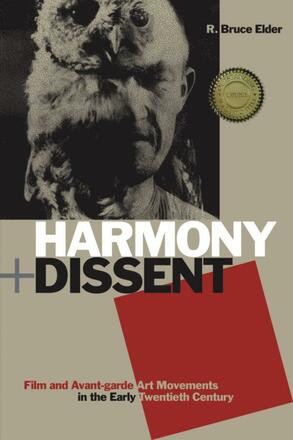
Harmony and Dissent
Film and Avant-garde Art Movements in the Early Twentieth Century
Description
R. Bruce Elder argues that the authors of many of the manifestoes that announced in such lively ways the appearance of yet another artistic movement shared a common aspiration: they proposed to reformulate the visual, literary, and performing arts so that they might take on attributes of the cinema. The cinema, Elder argues, became, in the early decades of the twentieth century, a pivotal artistic force around which a remarkable variety and number of aesthetic forms took shape.
To demonstrate this, Elder begins with a wide-ranging discussion that opens up some broad topics concerning modernity’s cognitive (and perceptual) regime, with a view to establishing that a crisis within that regime engendered some peculiar, and highly questionable, epistemological beliefs and enthusiasms. Through this discussion, Elder advances the startling claim that a crisis of cognition precipitated by modernity engendered, by way of response, a peculiar sort of “pneumatic (spiritual) epistemology.” Elder then shows that early ideas of the cinema were strongly influenced by this pneumatic epistemology and uses this conception of the cinema to explain its pivotal role in shaping two key moments in early-twentieth-century art: the quest to bring forth a pure, “objectless” (non-representational) art and Russian Suprematism, Constructivism, and Productivism.
Awards
- Short-listed, Raymond Klibansky Prize for Best Book in the Humanities 2009
- Commended, Outstanding Academic Title, Choice 2009
- Winner, Robert Motherwell Book Award for outstanding publication in the history and criticism of modernism in the arts 2009
Reviews
"Elder's research is staggering; form Platonic thought, Leonardo's Trattato dell pittura, analytical Newtonian principles governing the relationship between acoustics and optics, and Rudolf Steiner's anthroposophical treatises, to Jean-Philippe Rameau's notions on harmony and Viking Eggeling's film Diagonal-Symphonie.... Elder presents a radically altered perspective on the origins and influences that helped propel the artistic sensibilities of the early twentieth-century avant-garde in this absorbing text. Harmony and Dissent is highly recommended, in general, for those interested in pneumatic epistemology, film and visual arts in Russia and Europe and, more specifically, for academics and advanced students of Russian and Soviet cultural and cinema studies."
- Ilana Sharp
``Filmmaker Bruce Elder has added to his distinguished critical and scholarly works on avant-garde cinema his most original book, Harmony and Dissent: Film and Avant-garde Art Movements in the Early Twentieth Century. In it he makes a convincing case for the centrality of cinema as a unique mode of inspired cognition in the wake of the revolutionary art movements of the 1910s and 1920s. His learned investigation of the mystical heritage informing even the most dogmatically rationalist areas of modernist art and polemics puts the work of Richter, Eggeling, and Eisenstein in a thoroughly new and dazzling light.''
- P. Adams Sitney
"With a distinguished career as a filmmaker and critic, Elder (Ryerson Univ.) comes qualified to discuss this subject. In this rich, complex book, he sets out to explore both the 'absolute film tradition' as it developed principally in Germany and France (particularly in the work of Walther Ruttman, Hans Richter and Viking Eggeling) and the development of constructivism in the Russian tradition (especially in the work of Sergei Eisenstein).... Elder's masterful book is a must for everyone interested in cinematic modernism, particularly the early-20th-century European avant-gardes. Summing Up: Essential."
- K.S. Nolley
"To his credit, Elder brings self-assured skepticism to the movements and manifestos he probes, stating at the outset that the spiritual interests of the early film and photography avant-gardes ‘were largely of a peculiar, woolly character’ and that he is scrutinizing these notions ‘in order to expose the stain that marks them’ (xi). Having said this, however, he pays them the respect of sustained and serious examination; he comes to illuminate them, not to bury them, and he provides us with more than enough information to arrive at our own conclusions while pondering his. He explicates, you decide. Working out his thesis in almost 500 scrupulously researched pages, complete with hundreds of endnotes and quotations in Greek and Cyrillic script, Elder visits some historical areas that others have charted in the past, but which take on new significances in this distinctive context, especially when analyzed in such meticulous detail. At other times he sets forth facts, hypotheses, and speculations that I've encountered nowhere else.... Harmony and Dissent is as expansive, imaginative, fact-filled, and action-packed as any film-related book I've come upon in ages. Like most of the artists, theorists, inventors, mystics, and visionaries he writes about, Elder is blessed with a sense of mission that rules out shortcuts and compromises. The result of his labour is intensely challenging at times, but its insights are copious and its scholarship is a wonder to behold."
- David Sterritt